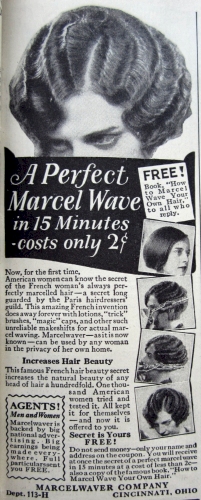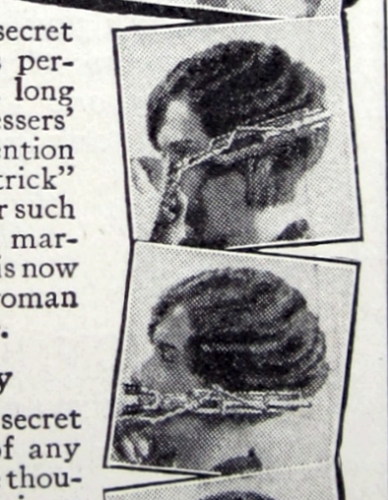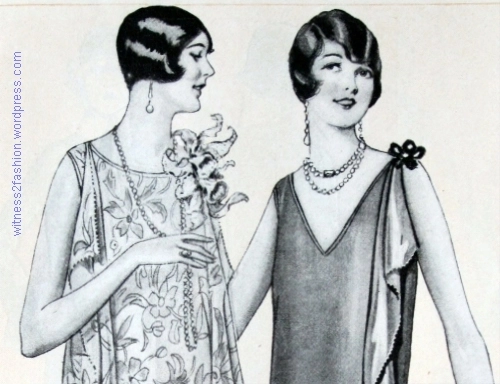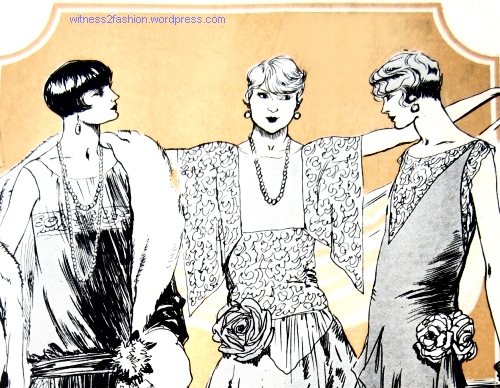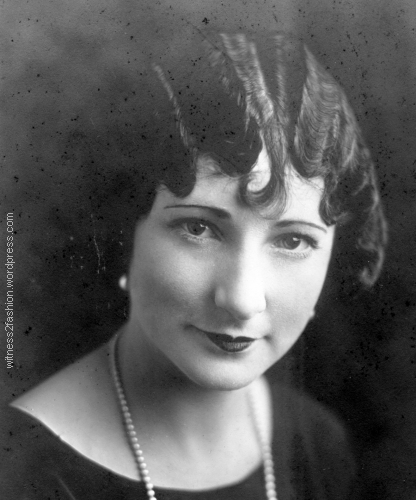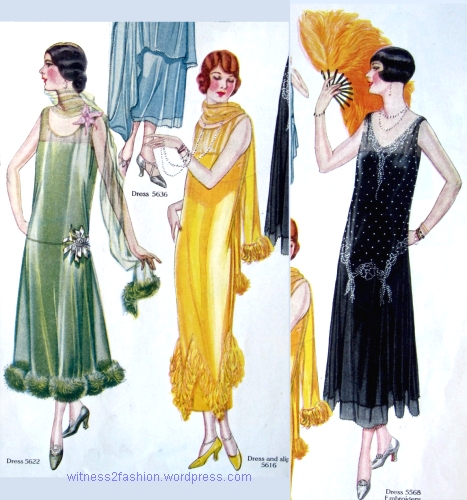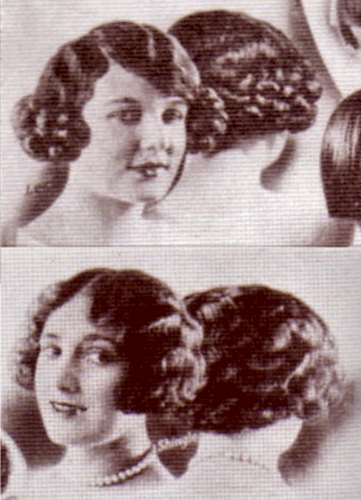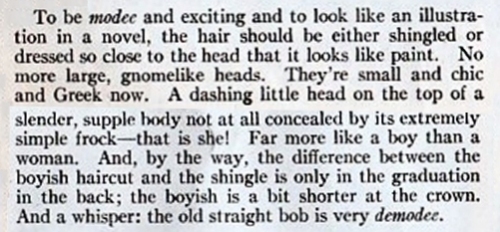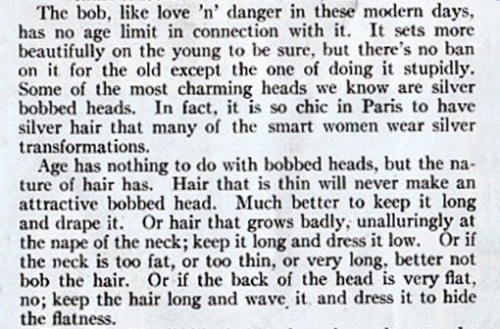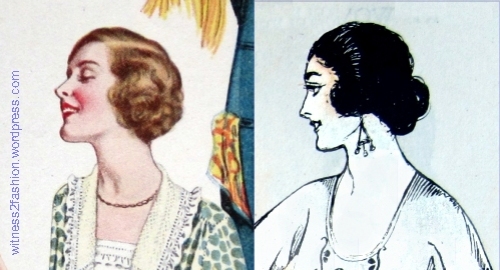These women are enduring a hair-raising experience in the hope of looking like this:

Cover illustration, The Delineator, August 1931. A softly waved “Marcel” hairdo with a low bun in back. The artist is probably Dynevor Evans.
The hairstyle known as a “Marcel” — and the permanent waving process named after its inventor — had been around long before the 1920’s, (click here for more about Monsieur Marcel Grateau’s 1872 innovation) but the combination of changing styles in hats and a switch from the “boyish” ideal to a softer, more feminine appearance as “the twenties” became “the thirties” made the deeply waved “Marcel” especially appealing to women.
Cloche hats could leave your coiffure seriously squashed when the hat was removed.
Many women who had bobbed hair in the twenties also had permanents. If they didn’t have perms or naturally curly hair, perspiring in a cloche could ruin a hairstyle. For more about early (and curly) 1920s hair styles, click here.
Permanent Waves, 1920’s
The C. Nestle Company sold electric permanent waving equipment like this to hair salons .

C. Nestle Permanent Hair Waving Machine, illustration from An Illustrated History of Hairstyles, by Marian I. Doyle.
Nestle also sold home permanent machines, which heated just one roller and plugged into an electric light socket, since most homes did not have wall-sockets in every room.
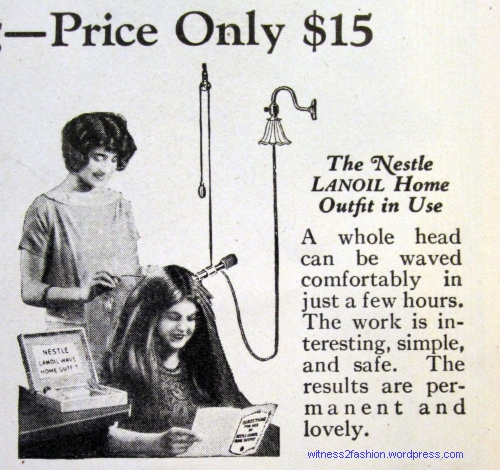
From Nestle Lanoil Home Permanent ad, Delineator, Dec. 1924. “A whole head can be comfortably waved in just a few hours.”

Nestle Home Permanent ad, Delineator, July 1924. Marcelled hair style at top. Early 1920’s bobbed hair on the right.
The satisfied customer on the lower left is only five and a half years old.
Many women now in their eighties must remember these machines, because they were still in use in the 1940s. In fact, I was even younger than the little girl in the Nestle ad when my mother took me to a “beauty parlor” to have my hair permanently curled.
What I remember is how very heavy the porcelain insulators — like those in this picture — were.
Other Ways to Marcel Your Hair

“American women can know the secret of the French woman’s always perfectly marcelled hair…. Marcelwaver — as it is now known — can be used by any woman in the privacy of her own home.”
The Marcelwaver seems to be a clamp that crimps waves into your hair, but the ad does not say it is heated by electricity. However, the photo at bottom seems to show a twisted electric cord leading to the appliance.
Very Short Hair in the Mid-1920’s

All the women wear shingled hair at this fashionable dance. Illustration from The Delineator, July 1928. (Typo edited 4/17/15]
Hair worn very short, and “shingled” to taper close to the head in back, was part of the “boyish” look that was adopted even by chic older women in the mid to late 1920’s. (For more about bobbed and shingled hair in the mid-twenties, click here.) It was not bulky, so it “worked” under a cloche hat, leaving small amounts of hair visible on the cheek.
Women who wanted to wear tight-fitting cloche hats in the 1920’s, but did not want to cut off their long hair, could twist it into a chignon worn very low on the neck in back.

From an article on hair styles, The Delineator, May, 1926. The waves on the far right are Marcelled.
Not all Marcelled hair was worn long.

Marcel waved hair styles from a Mulsified Cocoanut Oil Shampoo ad, The Delineator, February, 1929. A longish bob is worn by the model on the left; the two on the right have long hair.
Longer Hair Returns with the 1930’s
As early as September of 1928, The Delineator’s beauty editor, Celia Caroline Cole, was writing about the return of longer hair — and the confusion it was causing.

“The men who create the styles of today and tomorrow give their verdict on the return of long hair.” Delineator, September, 1928.
“One of the most chic hairdressers in the world told me . . . that the bob is surely passing. Then two blocks down that same broad street, another hairdresser, equally swanky, assured me that . . . the bob will never go — it is here to stay.”
The first hairdresser reminded her that “Styles are a part of life. And youth catches on to them first. Youth makes us do what it wants. The young girls now are letting their hair grow — they don’t want to look like women of forty — and soon women of forty will let their hair grow because they don’t want to look like women of forty either. They will do what youth does.”
” ‘Have you seen women of forty with that little knot at the back of their heads?’ I demanded.
” ‘I know,’ he agreed, ‘they look their years, but they will adapt to their needs this new style as they did the bob. And they will dislike the hairpins, but they will let it grow, just the same — not right away, but gradually, like the skirts — you say that you will never give up short skirts, but here they are, an inch or two longer this autumn, still a little longer next spring, and so on. One is helpless before this evolution, this ‘style’ — Youth sees it coming, and catches it, and we follow. The bob is going. “
Celia Cole noted, “The general trend is much more hair about the face, framing it softly.” That is what the waves of the Marcel did for women in the late nineteen twenties and early thirties.
However, in 1928, the other “swanky” hairdresser Celia Cole consulted said, ‘The bob going? Not for years and years, maybe never. Women seek more and more freedom — and they will go on seeking it. . . . Oh, no, women like you will not go back to hairpins and something dragging at their heads. Young girls must try out the unknown — they have never had long hair dragging at their heads, hairpins jabbing in, but last spring all my young clients came in and had the hair they had been growing all winter cut off again.”
Cole concludes that “We can do as we like. . . . What is style for you? The thing that exactly suits your type.”
However, by 1931 she was writing about “The Return of the Long Lost Locks — Hair styles have completely changed.”

Longer hair returns, August 1931 article from The Delineator. The model is actress Tallulah Bankhead.
By 1931, fashions had changed, and hairstyles with them. Hemlines had plummeted. Young women were wearing “uplift” brassieres that separated the breasts instead of flattening them. The waistline had returned to its natural location.
“Nothing sleek and hard is left in the feminine world today.” “The masculine neckline has vanished as completely as the dinosaur.” “Weary of realism and boyish, frankly displayed bodies, we’re going to play at romanticism.” — Celia Caroline Cole, The Delineator, August 1931.
“There was a moment, in this evolution of hair out of restrained boyishness into feminine curls, when the fashionists and coiffeurists came to blows. ‘We’ll keep the bob!’ the coiffeurists cried…. ‘Let it grow!’ the fashionists shouted back, their minds on ruffles and bows and little tip-tilted hats.”
In fact, the change in hat styles took place very gradually, but as the cloche hat receded, more hair became visible, especially as the “tip-tilted” hats of the 1930’s began to be worn on the side of the head and tilted down over one eye.
In the late twenties, “the human parade that wanders up and down the streets saw only hats, close little hats that hugged every woman’s head and revealed only a wisp or two of hair making arabesques on her cheeks. Then all of a sudden [last March] forth they came — all those long lost locks! . . . In joyous abandon, they waved and curled and pushed hats ‘way over on one ear.” — Celia Cole, August 1931.
In May of 1932, The Delineator ran this article, “If You Are Going to Have a Permanent,” reassuring women that the process was safe — even for dyed or gray hair. Although they had been available for years, permanents still needed to be explained.

Bottom of Article “If You Are Going to Have a Permanent,” May, 1932 This hairstyle has a little roll of curls at the neck, just like the model wearing the $1.69 hat below.
The article concludes, “Most permanents have to be set after each shampoo unless you are very clever and use your combs or fingers skillfully. It depends on the setting, whether you look like a Fiji Islander [or a 1925 movie star] or a sculptured lady.”
The “long bob permanent” pictured above looks very much like the hair on this hat model:

Hats from Sears Roebuck catalog, Spring 1933. Hats show more hair, and the “long bob permanent” Marcel wave ends in a soft roll of curls at the back.
Changes in hat styles and hair styles happen in reaction to each other.







